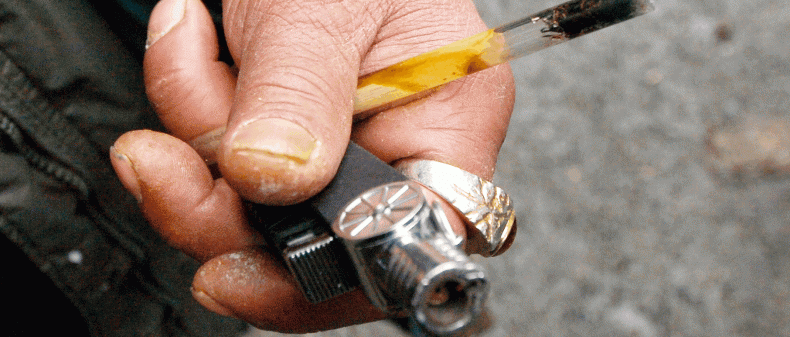
When you’re fiending for a fix, the only thing that matters is getting that heroin in your system as fast as you can. Who cares if you end up contracting AIDS from a shared needle? All that matters is getting high, now. The urge to get high is so strong that it trumps any kind of rational thought. “It’s stronger than the urge to piss,” Sally says.
On this wet March afternoon, Sally, a sixty-something drug user, has heroin but no clean needle. She often found herself in this situation back in her youth, when needle exchanges and other harm reduction programs were unheard of in Canada. No worries–Sally and her junkie friends shared the same needle, passing it around as if it were a joint. When it dulled, they’d sharpen it on a matchbox — problem solved. When it got so out of shape that it was unusable, they’d steal a fresh batch from a clinic.
But Sally hasn’t stolen, shared or sharpened a needle in years. It’s not because she doesn’t shoot the stuff anymore–far from it. It’s just that these days, she can stroll into the harm reduction room at her local community health centre and get a fistful of clean needles, no questions asked.
The harm reduction room is a colourful place. The wall is plastered with informational pamphlets on how to locate a vein with a needle, how to respond to a mental health crisis and how to practice safe sex. There are maps showing where clean drug supplies can be procured around Toronto. There are so many pamphlets and posters–among them a colourfully illustrated overdose reaction guide reminiscent of the CPR posters in high school science classrooms–that you can only catch the occasional sliver of orange wall. At the far end of the room, there is a steel cupboard containing all kinds of drug kits and paraphernalia. Beside the cupboard sits a yellow biohazard container for used needles. Clients are encouraged to dispose of their needles there and not in parks and alleys.
Sally says that without harm reduction services, she never would have made it into her sixth decade. A few years ago, British rehab centre Focus12 ran an award-winning ad campaign with the tagline “There’s no such thing as an old junkie”. Sally may beg to differ. Drug users like her are living longer and longer, and harm reduction takes a lot of the credit for that.
###
Over the last two decades, several studies have shown harm reduction programs to be effective in reducing deaths due to infectious disease and overdose. The scientific evidence also largely contradicts the claim that such programs provoke an increase in drug use. Indeed the World Health Organization is a staunch supporter of harm reduction as an intervention for drug abusers at risk of contracting STDs.
Studies have also shown that purely law-enforcement-based approaches towards tackling drug problems are inadequate. In 2000, Canadian police seized around 100kg of heroin in one of the largest drug busts in Canadian history. But a 2003 study led by Dr. Evan Wood of the B.C. Centre for Excellence in HIV/AIDS showed that heroin street prices actually dropped after the seizure, suggesting that other heroin shipments compensated for the confiscated product. The raid also wasn’t found to produce any measurable public health benefits.
But while the ineffectiveness of law enforcement and the benefits of harm reduction are clear in the scientific literature, politicians stubbornly refuse to alter their stance. A good case in point is Vancouver’s supervised injection facility InSite. Despite numerous studies showing InSite to be a public health marvel, the federal Conservative government twice appealed to the courts to shut it down. Both appeals were rejected, prompting speculation that Toronto could be next in line for a supervised drug consumption facility. Those speculations rose to fever pitch in the wake of a report, released in April, which suggested that Toronto would benefit from having not just one but three supervised injection sites. The Toronto and Ottawa Supervised Consumption Assessment (TOSCA) was requested by the City of Toronto in 2005 to look into the feasibility and potential usefulness of drug consumption sites in the two cities. The 325-page report discusses numerous potential health and social benefits of supervised drug consumption sites in the city.
But how will these findings play with City Council? In 2010 Council voted to endorse the Vienna Declaration, a statement signed by thousands of scientists, law enforcement officials and legal experts, which calls for drug policy reform and recommends implementation of harm reduction measures. As a result, Toronto became the first municipality in the world to endorse the declaration. However, the handful of councillors who voted against included the current mayor Rob Ford and deputy mayor Doug Holyday. Councillors Mike Del Grande, Norm Kelly, Frances Nunziata and Gloria Lindsay Luby also voted against adopting the declaration. Most are reticent to discuss the reasons behind their vote, or their views on drug policy in general. Councillor Del Grande said in an email response that health and health care are a provincial responsibility, but did not go into any further detail.
Councillor Kelly says he understands the arguments in favour of harm reduction but was persuaded to vote against the motion by a constituent who had lived a life of drug abuse but was opposed to harm reduction. “I’ve read the literature, I’ve visited [InSite] in Vancouver, I talked to everyone there… but then I met this guy from the streets. He said to me, ‘Norm I’ve been in jail, I’ve done time, I’ve been involved with drugs and I know what goes on in the streets. No, no, no — don’t [vote in favour].’” Councillor Kelly also implied that harm reduction does not enjoy widespread support in the city. “It’s not something that could play in large communities in Toronto.”
The authors of the TOSCA study seem to agree. They allude to stiff community opposition as a significant hurdle facing the harm reduction movement. “Even residents and business owners… supportive of supervised consumption facility implementation did not necessarily want to see a facility in their own residential neighbourhoods or near their businesses,” the report says. Indeed just last summer, the South Cabbagetown Residents’ Association rallied successfully to prevent a methadone clinic from opening in that neighbourhood. MPP Glen Murray sheepishly admitted that community opposition was one of the primary reasons for shuttering the facility even before it opened for business.
But despite a lack of political will and an abundance of NIMBYism, harm reduction activists in Toronto refuse to give up. The Toronto Harm Reduction Task Force is a collective that has successfully championed for harm reduction services in the city. The group is headed by social worker Holly Kramer. She believes conventional rehab treatments based on an abstinence model simply don’t work for many addicts. “The issues drug users are trying to cover up with their drugs didn’t happen like that,” she says, snapping her fingers. “You didn’t get this fucked up in twenty-eight days and you’re not going to get fixed in twenty-eight days. Abstinence doesn’t work for a lot of people, and these are the people that need harm reduction services.”
Kramer says political obstacles and a lack of funding are halting the drive for more harm reduction services. Indeed, the Conservative government’s National Anti-Drug Strategy barely makes a mention of harm reduction, while seventy per cent of anti-drug funds are ploughed towards law enforcement. A recent article in the Canadian Medical Association Journal rightly describes harm reduction as “anathema” to the Harper government.
It’s a stance that doesn’t sit well with Dr. Philip Berger, medical director of the Inner City Health Program at St. Michael’s Hospital. “Law enforcement approaches have been around for a long time, but every analysis of the so-called ‘war on drugs’–prosecution, imprisonment, etc.–has shown that it has failed miserably to reduce drug use or the illnesses and death associated with it,” he says.
Nevertheless, the war on drugs is poised to continue and — with the Omnibus Crime Bill C-10 passed by parliament a few months ago — gain new momentum. The bill calls for mandatory minimum sentences for drug offenders, and is designed to shovel drug offenders into prison even for minor offences like possession.
###
Drug use is rampant in Toronto’s Don Jail, despite the CSC employing various measures — searches, urine testing, frisking of visitors, drug detection dogs, etc. — to try and prevent it. Marijuana, crack and heroin still get in easily, brought in by corrupt prison guards, smuggled in by visitors, and hidden in the stomachs and anuses of incoming inmates.
Imprisoned drug pushers will often get someone on the outside to commit a minor crime in broad daylight and smuggle drugs into the lucrative prison drug market on their way in. A gram of weed — $10 on the street — can go for $50 in the Don. Drug dealing is a popular vocation, and spawns widespread drug use.
In a 2007 survey conducted by the Correctional Services of Canada (CSC), 17% of male and 14% of female inmates admitted to injecting drugs while in prison, 60% of the time with a used needle. Anecdotal evidence suggests that many inmates get initiated into drug use while in prison, due to the stifling social pressure to use drugs. Inmates who refuse drugs and avoid the company of drug users in prison run the risk of being accused of being snitches. As a result, anxious inmates new to the prison system often give in easily when offered a drag of a crack spliff. Survival often means fitting in, and fitting in can mean taking that hit of crack. The inmates applying the social pressure are often drug dealers on the lookout for new customers.
In the outside world, we’re told to avoid the people and environments that put us at risk for getting into drugs. But in prison, there’s nowhere to hide. And everything about the prison environment makes people want to use drugs. A few years ago, a South Asian man named Raj (name changed) landed in a Toronto prison for a white-collar beef. Raj was accustomed to wearing designer suits and driving nice cars, yet here he was sporting an orange jumpsuit and sleeping on a mattress on the floor because both bunks in his cell were claimed. This meant his head was right below the night light and his feet by the toilet. The cell was cold. His cellmates were dirty. Raj barely slept his first week in prison. And then he discovered the prescription painkiller Oxycontin. It gave him a good buzz, and helped him relax. He quickly got hooked, and lay in his cell most of the day, ripping on Oxies.
Stories like these are all too familiar to Andy Smith (name changed to protect source’s desire for privacy), a former crack addict who now works as a harm reduction coordinator for a non-profit organization. Smith spent five years in the Don Jail. He says the constant, unyielding stress of prison life drives inmates to drug use. “Prison life is like someone yelling in your face all day long, so close to you that you can feel the particles of spit hitting your face, and there’s nothing you can do to avoid him,” Smith says. “Imagine going to sleep, and the second you fall asleep, this person appears in your face and he’s yelling at you. That’s how frustrating it is. On top of that, you’re hungry, your cell’s cold, your three-inch mattress is wet and your cellmate won’t stop farting. Imagine dealing with that kind of stress every minute of the day, every day.”
Smith’s eyes glaze over and he cracks a sad smile as he talks about how drugs helped him escape from the chaos that surrounded him in prison. “It’s a coping mechanism. It’s something you start to need. Just to be able to have a complete thought, or feel some kind of peace, or go to a happy place.” He pauses for several seconds, before picking up where he left off. “You can’t daydream and go to a happy place in prison because of the constant noise and confusion, so you get high. Being high in prison is like being really warm outside on a cold, winter day.”
“Drug users in prison aren’t that different from people in the outside world,” he continues. “You know how if you have a bad day you go, ‘Oh man, I need a drink’? Well in prison there’s no drink. But you’re left with that need. Say you’re on the telephone with your wife. She gets mad at you and hangs up on you and you can’t even leave or do anything to mend that situation. You’re stuck in this box with your emotions and feelings. What do you do? What do you do…?”
Smith asserts that drugs fill a void in prisoners’ lives, and for that reason alone there will always be a thriving drug market in prison. CSC continues to introduce measures to prevent this–including hiring new intelligence personnel, enhancing security protocols and expanding the drug detector dog program — but Smith feels they’ll never be enough. “They’ll never stop the drugs from coming in.”
He claims that prison is anything but rehabilitative for drug offenders. “I’d get arrested for drug offences but my drug problems were not addressed,” he says. “Drug addiction is not a criminal issue. People use drugs to feed their addiction, which comes from a desire to escape from trauma. By imprisoning someone, you’re only feeding them more trauma. Doing time doesn’t rehabilitate people, it makes people worse.”
“Politicians are just trying to sweep people who have drug problems under a rug, but there’s not enough space under that rug for all those people.”
###
Unlike many of his fellow inmates in the Don, Smith managed to beat his addiction, and for that he credits harm reduction. Despite going to over half a dozen traditional rehab centres in an attempt to kick his habit, it was an encounter with a woman working at a safe crack kit distribution facility on Dundas and Sherbourne that set him on the road to recovery. “This woman treated me like an individual, and it was very different from what I had previously encountered,” he says. “She showed me compassion, which built my self-esteem and helped me get to a place where I believed I could live without getting high.”
“You see, harm reduction lets you know that you are a part of the community, and it’s up to you what role you want to play in the community,” he says. “Criminal approaches force you to play the role of a drug user, and compel you to remain out of the community until you’re clean. And that’s not realistic”
Smith scoffs at the suggestion that distributing drug paraphernalia could encourage more people to do drugs. “Let’s say I offer you a bag of heroin and an injection kit right now. Are you going to use it just because I’m giving it to you? No. People who have decided to use are going to use either way.” He adds that strategies based on harm reduction are the best way to get people to curb their drug use.
Smith cites “peer work” as one of the most effective strategies. Peer workers are former and current drug users employed by public health agencies to distribute clean drug supplies and information. “Before, these were just people using drugs on the street who were rejected by society,” he says. “Now they’re actively involved, and the time they spend working is time away from using drugs.”
Peter Leslie is one such actively involved figure. He is a peer worker in his fifties, a trained paramedic and a regular cocaine user. “Clients light up when they see my face. It’s a shared experience — it’s life-affirming and life-changing for peer workers and regular drug users,” he says. “Also, us peer workers are expected to be reliable and functioning, so that helps us deprioritize our own drug use.” According to Leslie, peer workers’ personal experience with drug-related issues allows them to relate to drug users in a non-judgmental way, and help them using an approach centred on empathy and compassion.
Recently, one harm reduction activist took it upon himself to write an entire book on this alternative approach. Dealing with Addiction: Why the 20th Century Was Wrong is written by Dr. Peter Ferentzy, 52, an addiction researcher, occasional crack user and recovering alcoholic who was inspired to write the book after two close friends died of overdose. Dr. Ferentzy says the second death, which occurred at the end of August 2010, drove him to write the book. “By mid-November, I started writing the book. By December 3, the first draft was finished. By May, it was in print,” says Dr. Ferentzy, a stocky, muscular man with intense, angry eyes and a permanent scowl. “I wasn’t fucking around.”
Dr. Ferentzy believes addicts are an oppressed group much like gays, blacks and women, and that harm reduction is their route to emancipation. He adds that harm reduction isn’t merely beneficial for addicts, but spawns wider benefits. He points out that while Toronto’s gay pride march might have alienated people and businesses at first, it has ultimately made the city more attractive to businesses and professionals. Similar benefits can be obtained by treating drug users better, he says. “If you start treating addicts right, your city will be more attractive to businesses in the long-term. It’s good business, it’s good for the common citizen and of course it’s good for the addict.”
Dr. Ferentzy isn’t too worried about the passing of the Omnibus Crime Bill or the fact that Toronto’s municipal government and Canada’s federal government are both vehemently opposed to harm reduction. “There will be hold-backs,” he says, “but history will run its course.”
“The politicians and other critics who oppose harm reduction are on the wrong side of history, and they will be judged harshly.”
____
Rahul Kalvapalle is a journalism masters student at Ryerson University. Follow him on twitter at @rahulkalvapalle.
For more, follow us on Twitter @TorontoStandard and subscribe to our newsletter.














